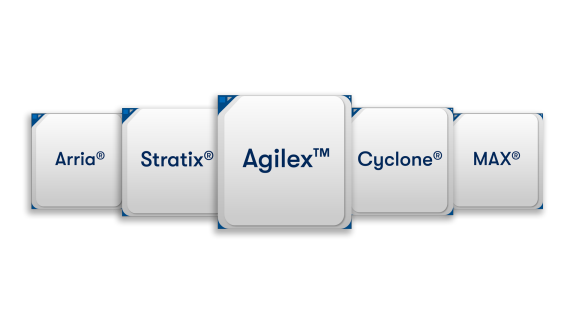Altera® FPGA และโซลูชันแบบตั้งโปรแกรมได้
สัมผัสความยืดหยุ่นอย่างที่คุณต้องการและเร่งนวัตกรรมของคุณด้วยกลุ่มผลิตภัณฑ์ลอจิกที่ตั้งโปรแกรมได้อันหลากหลาย รวมไปถึง เอฟพีจีเอ, CPLD, ASIC แบบมีโครงสร้าง, แพลตฟอร์มการเร่งความเร็ว, ซอฟต์แวร์ และ IP
ดาวน์โหลดแคตตาล็อกผลิตภัณฑ์เอฟพีจีเอ
เรื่องเด่น
วิธีการหยิบยื่นอุปทานที่แข็งแกร่งในโลกที่ซับซ้อนและเปลี่ยนไปเสมอ
เรียนรู้ว่าการผสมผสานของการวางแผนอย่างรอบคอบ การลงทุนที่เจาะจง การติดตามที่แม่นยำ และความมุ่งมั่นที่จะยืดอายุการใช้งานของผลิตภัณฑ์ จะทำให้เกิดห่วงโซ่อุปทานแบบคล่องตัวที่ลูกค้า FPGA ต้องการอย่างไร
การวิเคราะห์พลังงานและประสิทธิภาพของ Finite Impulse Response Filters (FIR) และ Fast Fourier Transforms (FFT) บน Agilex™ 7 FPGA
เอกสารนี้จะวิเคราะห์การประหยัดพลังงานและประสิทธิภาพของหลายๆ การกำหนดค่า FIR และ FFT บน Agilex™ 7 FPGA และ Versal FPGA ของ AMD
การประยุกต์ใช้หลักๆ ของ Agilex™ 5 FPGA E-Series
สำรวจการประยุกต์ใช้หลักๆ ที่ Agilex™ 5 FPGA E-Series ถูกสร้างขึ้นมาให้ และวิธีการที่คุณสมบัติและความสามารถหลักๆ ของผลิตภัณฑ์นี้รับมือกับความท้าทายต่างๆ สำหรับการออกแบบยุคใหม่
การออกแบบกล้อง 4K ยุคใหม่ด้วย Agilex™ 5 FPGA
เรียนรู้วิธีการประยุกต์ใช้และได้ประโยชน์จาก Agilex™ 5 FPGA และการรวบรวม IP มากมายเพื่อพัฒนาโซลูชันกล้องวิทัศน์อย่างเต็มรูปแบบ
ADC/DAC ในตัว
Intel FPGA พร้อมตัวแปลงข้อมูลประสิทธิภาพสูงในตัวช่วยให้ลูกค้าได้รับแบนด์วิดท์ชั่วขณะที่กว้างและขีดความสามารถของ Direct RF พร้อมกับประสิทธิภาพที่เพิ่มขึ้น พลังงานที่น้อยลง และขนาดผลิตภัณฑ์ที่ลดลง
การประมวลผลสัญญาณดิจิตอล
Intel FPGA มาพร้อมบล็อก DSP ความแม่นยำแปรผันที่รองรับการดำเนินการจุดลอยตัว ทำให้ได้การปรับใช้ฟังก์ชั่นการประมวลผลสัญญาณที่หลากหลายอย่างมีประสิทธิภาพและการประหยัดพลังงานสูง
อินเทอร์เฟซหน่วยความจำภายนอก
ตอบโจทย์ด้านแบนด์วิดท์หน่วยความจำด้วยอินเทอร์เฟซที่มีประสิทธิภาพและการประหยัดพลังงานสูงสำหรับหน่วยความจำภายนอก เช่น DDR4, DDR5 และอื่นๆ อีกมากมาย
การผสานการทำงานที่ต่างกันโดยใช้ Chiplet
แนวทางที่ใช้ Chiplet ของ Intel กับการผสานการทำงานที่ต่างกัน ช่วยเพิ่มอัตราของนวัตกรรมเอฟพีจีเอและทำให้เกิดการปรับแต่งผลิตภัณฑ์ในระดับใหม่
เครื่องรับส่งสัญญาณ
Intel ช่วยจัดการกับข้อกำหนดด้านแบนด์วิดท์ยุคใหม่ด้วยเทคโนโลยี I/O ของเครื่องรับส่งสัญญาณชั้นนำของอุตสาหกรรม
แหล่งข้อมูล

แหล่งข้อมูลสนับสนุน
ค้นหาแหล่งข้อมูลสนับสนุนของเอฟพีจีเอ ข้อมูลวิธีการแก้ปัญหาด้วยตนเอง คำแนะนำทีละขั้นตอน บทความฐานความรู้ และอีกมากมาย

เอกสาร
เข้าใช้งานคอลเล็คชั่นดัชนีเอกสารประกอบของเอฟพีจีเอเพื่อค้นหาคู่มือผู้ใช้ เอกสารข้อมูล เอกสารเผยแพร่ และอีกมากมาย

การฝึกอบรม
ลงลึกและขัดเกลาทักษะด้านการออกแบบเอฟพีจีเอของคุณด้วยการฝึกอบรมเชิงเทคนิคสำหรับเอฟพีจีเอ Intel

เพิ่งเริ่มรู้จักเอฟพีจีเอ
ดูว่าเอฟพีจีเอคืออะไร และศึกษาแหล่งข้อมูลต่างๆ เพื่อเริ่มต้นการออกแบบของคุณเอง
